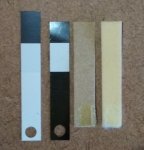When using mostly vinyl valves you are typically still required to use leather/vileda on the lower notes.
Are there any general rules regarding the point at which you switch from vinyl to thicker valves? Obviously if youre replacing existing valves of the same kind you can just follow what is already there. But what if youre coming from an all-leather setup? Or even just building from scratch?
I know there are opinions on the sound colour influence of the valves (e.g. by suppressing or highlighting harmonics). And there are also some other differences, like longevity, response, moisture absorption (as per Accordion Revival). I am not asking about those - I am interested in the noise aspect here.
In one of Toni Schwalls books he mentions that if the reed has a weight at the end then you definitely want to use leather/vileda. Also on the bass side you should try to use the same kind of valve within a rank because of the sound colour influence, i.e. dont switch over from vileda to vinyl halfway on one side of a block.
What Ive seen on both my 1950s Hohner Morinos is that on the treble side theyll have leather up to around E3 and after that they switch to vinyl. On the bass side theyll have leather on Bass 1 and Bass 2, and then vinyl on the chord ranks. In both cases leather valves are used beyond just those reeds with added weights. Toni Schwall also has some examples of instruments and where they go from leather/vileda to vinyl to nothing. They all seem to use leather a bit past those reeds with added weights.
So what exactly is the logic behind the noise aspect here? Ive got sets of vinyl valves that are large enough (and one that is even larger) than those low treble reeds. So technically speaking the valve will fit correctly, but I believe this is where the noise issue comes in. At some point the vinyl-only valve will be noisier, but why? Is this primarily due to the frequency of the reed, or more the physical dimensions of the reed or the valve?
For example, if I had a long, non-weighted low reed, would a sufficiently long vinyl valve be okay? Or would a thicker valve still be suggested?
Otherwise, do those longer vinyl valves perhaps have some very specific use case?
Are there any general rules regarding the point at which you switch from vinyl to thicker valves? Obviously if youre replacing existing valves of the same kind you can just follow what is already there. But what if youre coming from an all-leather setup? Or even just building from scratch?
I know there are opinions on the sound colour influence of the valves (e.g. by suppressing or highlighting harmonics). And there are also some other differences, like longevity, response, moisture absorption (as per Accordion Revival). I am not asking about those - I am interested in the noise aspect here.
In one of Toni Schwalls books he mentions that if the reed has a weight at the end then you definitely want to use leather/vileda. Also on the bass side you should try to use the same kind of valve within a rank because of the sound colour influence, i.e. dont switch over from vileda to vinyl halfway on one side of a block.
What Ive seen on both my 1950s Hohner Morinos is that on the treble side theyll have leather up to around E3 and after that they switch to vinyl. On the bass side theyll have leather on Bass 1 and Bass 2, and then vinyl on the chord ranks. In both cases leather valves are used beyond just those reeds with added weights. Toni Schwall also has some examples of instruments and where they go from leather/vileda to vinyl to nothing. They all seem to use leather a bit past those reeds with added weights.
So what exactly is the logic behind the noise aspect here? Ive got sets of vinyl valves that are large enough (and one that is even larger) than those low treble reeds. So technically speaking the valve will fit correctly, but I believe this is where the noise issue comes in. At some point the vinyl-only valve will be noisier, but why? Is this primarily due to the frequency of the reed, or more the physical dimensions of the reed or the valve?
For example, if I had a long, non-weighted low reed, would a sufficiently long vinyl valve be okay? Or would a thicker valve still be suggested?
Otherwise, do those longer vinyl valves perhaps have some very specific use case?


